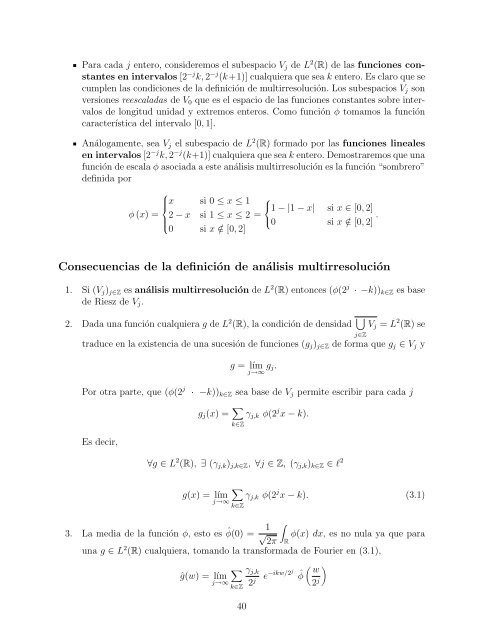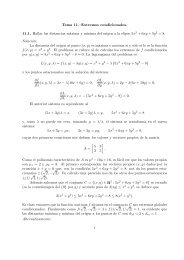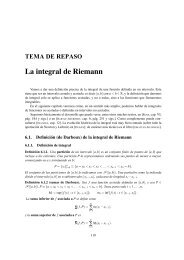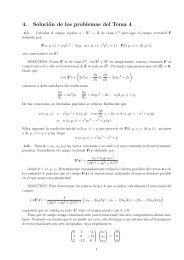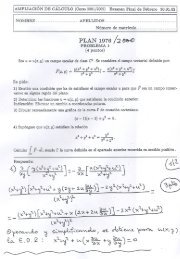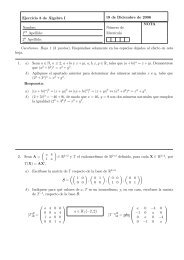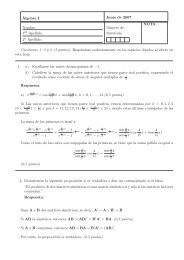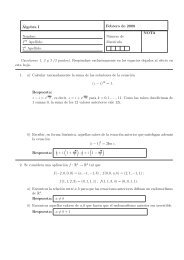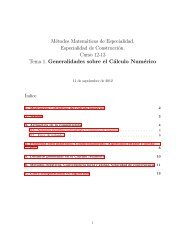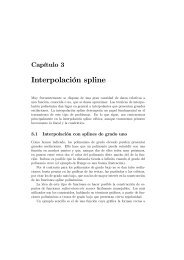La transformada wavelet: una introducción - Departamento de ...
La transformada wavelet: una introducción - Departamento de ...
La transformada wavelet: una introducción - Departamento de ...
Create successful ePaper yourself
Turn your PDF publications into a flip-book with our unique Google optimized e-Paper software.
Para cada j entero, consi<strong>de</strong>remos el subespacio Vj <strong>de</strong> L 2 (R) <strong>de</strong> las funciones constantes<br />
en intervalos [2 −j k, 2 −j (k+1)] cualquiera que sea k entero. Es claro que se<br />
cumplen las condiciones <strong>de</strong> la <strong>de</strong>finición <strong>de</strong> multirresolución. Los subespacios Vj son<br />
versiones reescaladas <strong>de</strong> V0 que es el espacio <strong>de</strong> las funciones constantes sobre intervalos<br />
<strong>de</strong> longitud unidad y extremos enteros. Como función φ tomamos la función<br />
característica <strong>de</strong>l intervalo [0, 1].<br />
Análogamente, sea Vj el subespacio <strong>de</strong> L 2 (R) formado por las funciones lineales<br />
en intervalos [2 −j k, 2 −j (k+1)] cualquiera que sea k entero. Demostraremos que <strong>una</strong><br />
función <strong>de</strong> escala φ asociada a este análisis multirresolución es la función “sombrero”<br />
<strong>de</strong>finida por<br />
⎧<br />
⎪⎨<br />
x si 0 ≤ x ≤ 1 ⎧<br />
⎨1<br />
− |1 − x| si x ∈ [0, 2]<br />
φ (x) = 2 − x si 1 ≤ x ≤ 2 =<br />
⎪⎩<br />
⎩0<br />
si x /∈ [0, 2]<br />
0 si x /∈ [0, 2]<br />
.<br />
Consecuencias <strong>de</strong> la <strong>de</strong>finición <strong>de</strong> análisis multirresolución<br />
1. Si (Vj)j∈Z es análisis multirresolución <strong>de</strong> L 2 (R) entonces (φ(2 j · −k))k∈Z es base<br />
<strong>de</strong> Riesz <strong>de</strong> Vj.<br />
2. Dada <strong>una</strong> función cualquiera g <strong>de</strong> L2 (R), la condición <strong>de</strong> <strong>de</strong>nsidad <br />
Vj = L 2 (R) se<br />
j∈Z<br />
traduce en la existencia <strong>de</strong> <strong>una</strong> sucesión <strong>de</strong> funciones (gj)j∈Z <strong>de</strong> forma que gj ∈ Vj y<br />
Por otra parte, que (φ(2 j<br />
Es <strong>de</strong>cir,<br />
g = lím<br />
j→∞ gj.<br />
· −k))k∈Z sea base <strong>de</strong> Vj permite escribir para cada j<br />
gj(x) = <br />
k∈Z<br />
γj,k φ(2 j x − k).<br />
∀g ∈ L 2 (R), ∃ (γj,k)j,k∈Z, ∀j ∈ Z, (γj,k)k∈Z ∈ ℓ 2<br />
<br />
g(x) = lím γj,k φ(2<br />
j→∞<br />
k∈Z<br />
j x − k). (3.1)<br />
3. <strong>La</strong> media <strong>de</strong> la función φ, esto es ˆ φ(0) = 1<br />
<br />
√ φ(x) dx, es no nula ya que para<br />
2π R<br />
<strong>una</strong> g ∈ L2 (R) cualquiera, tomando la <strong>transformada</strong> <strong>de</strong> Fourier en (3.1),<br />
ˆg(w) = lím<br />
<br />
j→∞<br />
k∈Z<br />
40<br />
γj,k<br />
2j e−ikw/2j <br />
φˆ<br />
w<br />
2j


